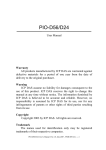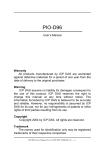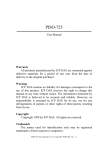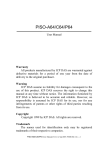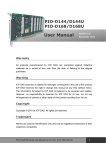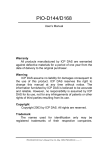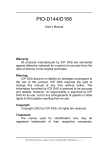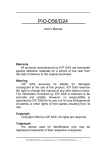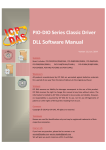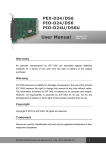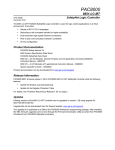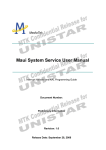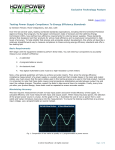Download PIO-D144/D168
Transcript
PIO-D144/D168 Digital I/O Card Linux Software Manual Warranty All products manufactured by ICP DAS are warranted against defective materials for a period of one year from the date of delivery to the original purchaser. Warning ICP DAS assume no liability for damages consequent to the use of this product. ICP DAS reserves the right to change this manual at any time without notice. The information furnished by ICP DAS is believed to be accurate and reliable. However, no responsibility is assumed by ICP DAS for its use, nor for any infringements of patents or other rights of third parties resulting from its use. Copyright Copyright 2003 by ICP DAS. All rights are reserved. Trademark The names used for identification only may be registered trademarks of their respective companies. PIO-D144/D168 Linux User’s Manual (Ver.3.0, May.2013) ----1 Tables of Contents 1 Linux Software Installation ....................................................................... 3 1.1 LINUX DRIVER INSTALLING PROCEDURE............................................................. 3 1.2 LINUX DRIVER UNINSTALLING PROCEDURE........................................................ 3 2. Static Library Function Description ........................................................ 4 2.1 TABLE OF ERRORCODE AND ERRORSTRING ........................................................ 5 2.2 FUNCTION DESCRIPTIONS .................................................................................... 5 2.3 DIGITAL I/O FUNCTIONS .................................................................................. 6 2.3.1 PIODA_GetDriverVersion ..................................................................... 6 2.3.2 PIODA_GetLibraryVersion ................................................................... 6 2.3.3 PIODA_Open ......................................................................................... 6 2.3.4 PIODA_Close ........................................................................................ 7 2.3.5 PIODA_DriverInit ................................................................................. 7 2.3.6 PIODA_DeviceInit ................................................................................. 8 2.3.7 PIODA_ PortDirCfs............................................................................... 8 2.3.8 PIODA_Digital_Output ......................................................................... 9 2.3.9 PIODA_Digital_Input ............................................................................ 9 2.3.10 PIODA_IntInstall ................................................................................. 10 2.3.11 PIODA_IntRemove............................................................................... 11 3. PIO-D144/D168 Linux Demo.................................................................... 12 3.1 3.2 3.3 3.4 3.5 3.6 DEMO CODE “PORT.C” ....................................................................................... 12 DEMO CODE “PORT2.C” ..................................................................................... 12 DEMO CODE “PORT_A.C” .................................................................................. 13 DEMO CODE “INT.C”.......................................................................................... 13 DEMO CODE “INT2.C”........................................................................................ 13 DEMO CODE “INT_A.C” ..................................................................................... 13 PIO-D144/D168 Linux User’s Manual (Ver.3.0, May.2013) ----2 1 Linux Software Installation The PIO-D144/D168 can be used in linux kernel 2.4.X and 2.6.X. For Linux O.S, the recommended installation and uninstall steps are given in Sec 1.1 ~ 1.2 1.1 Linux Driver Installing Procedure Step 1: Copy the linux driver “ixpio-0.20.15.tar.gz” (or the later driver version) in the directory “NAPDOS\Linux” of the companion CD or download the latest driver from our website to the linux host. Step 2: You must use the ‘root’ identity to compile and install PIO/PISO linux driver. Step 3: Decompress the tarball “ixpio.tar.gz”. Step 4: Type ‘cd' to the directory containing the package's source code and type ‘./configure' to configure the package for your linux system. Step 5: Type ‘make' to compile the package. Step 6: You can type ‘./ixpio.inst' to install the PIO/PISO driver module and build the device file “ixpioX” in the device directory “/dev” automatically. 1.2 Linux Driver Uninstalling Procedure Step 1: Type `cd' to the directory containing the package's source code. Step 2: Type `./ixpio.remove' to remove the PIO/PISO driver module. PIO-D144/D168 Linux User’s Manual (Ver.3.0, May.2013) ----3 2. Static Library Function Description The static library is the collection of function calls of the PIO-DIO cards for linux kernel 2.4.x and 2.6.x system. The application structure is presented as following figure. The user application program developed by C(C++) language can call library “libpio.a” in user mode. And then static library will call the module ixpio to access the hardware system. User's Application Function Call into Library Development Toolkit Static library “libpio.a” Services Call into Kernel-Mode ixpio.ko (Device Driver) Device Control Hardware Devices Figure 2.1 PIO-D144/D168 Linux User’s Manual (Ver.3.0, May.2013) ----4 2.1 Table of ErrorCode and ErrorString Table 2.1 Error Code Error ID Error String 0 PIODA_NOERROR OK ( No error !) 1 PIODA_MODULE_NAME_GET_ERROR Module name can't get from file /proc/ixpio/ixpio 2 PIODA_DEVICE_DIO_INIT_ERROR Configure port DI/O error 3 PIODA_ACTIVE_PORT_ERROR Select I/O port error 4 PIODA_PORT_DEFINED_ERROR Port number out of range 5 PIODA_DIGITAL_OUTPUT_ERROR Digital output error 6 PIODA_DIGITAL_INPUT_ERROR Digital input error 7 PIODA_INT_SOURCE_DEFINED_ERROR Interrupt error 8 PIODA_CONFIGURE_INTERRUPT_ERR OR Configure interrupt error 9 PIODA_ACTIVEMODE_DEFINED_ERRO R Defined Interrupt mode error PIODA_ADD_SIGNAL_ERROR Add signal condition error 10 source 2.2 Function Descriptions Table 2.2 Function Definition char * PIODA_GetDriverVersion(void); char * PIODA_GetLibraryVersion(void); int PIODA_Open(char *dev_file); WORD PIODA_Close(WORD fd); WORD PIODA_DriverInit(WORD); WORD PIODA_DeviceInit(WORD fd); WORD PIODA_PortDirCfs(WORD, WORD, boolean); WORD PIODA_Digital_Output(WORD, WORD, byte); WORD PIODA_Digital_Input(WORD, WORD, WORD *); WORD PIODA_IntInstall(WORD, HANDLE, WORD, WORD, WORD); WORD PIODA_IntRemove(WORD, WORD); PIO-D144/D168 Linux User’s Manual (Ver.3.0, May.2013) ----5 defined active 2.3 Digital I/O FUNCTIONS 2.3.1 • PIODA_GetDriverVersion Description: To get the version of PIO/PISO linux driver. • Syntax: char* PIODIO_GetDriverVersion(Void) • Parameter: None • Return: The version of PIO/PISO linux driver. 2.3.2 • PIODA_GetLibraryVersion Description: To get the version of PIO/PISO linux static library. • Syntax: char* PIODIO_GetLibraryVersion(void) • Parameter: None • Return: The version of PIO/PISO linux static library. 2.3.3 • PIODA_Open Description: To open device file. • Syntax: int PIODIO_Open(char *dev_file) • Parameter: PIO-D144/D168 Linux User’s Manual (Ver.3.0, May.2013) ----6 dev_file : The path of device file Return: The file descriptor of device file. If the file descriptor < 0, it means that open device file failure. 2.3.4 • PIODA_Close Description : To close device file. • Syntax : Word PIODIO_Close(WORD fd) • Parameter : fd : The file descriptor of device file that get from function PIODIO_Open • Return: “PIODA_NOERROR” (Please refer to "Section 2.1 Error Code"). 2.3.5 • PIODA_DriverInit Description : To allocates the computer resource for the device. This function must be called once before applying other PIODA functions. • Syntax : WORD PIODA_DriverInit(WORD fd) • Parameter : fd : The file descriptor of device file that get from function PIODIO_Open • Return: “PIODA_MODULE_NAME_GET_ERROR”, “PIODA_NOERROR”, (Please refer to "Section 2.1 Error Code"). PIO-D144/D168 Linux User’s Manual (Ver.3.0, May.2013) ----7 2.3.6 PIODA_DeviceInit Description : To send initial-value to the D/O latch register of active port. Syntax : WORD PIODA_DeviceInit(WORD fd) Parameter : fd :The file descriptor of device file that get from function PIODIO_Open. Return : “PIODA_DEVICE_DIO_INIT_ERROR”, “PIODA_NOERROR”. (Please refer to "Section 2.1 Error Code"). 2.3.7 • PIODA_ PortDirCfs Description : To change Digital I/O port. status(DI or DO). • Syntax : WORD PIODA_PortDirCfs(WORD fd, WORD port, boolean io) • Parameter : fd : The file descriptor of device file that get from function PIODIO_Open. port : The.port number that want to change status(DI or DO) io : The value 0 means digital output. The value 1 means digital input. • Return: “PIODA_DEVICE_DIO_INIT_ERROR”, “PIODA_NOERROR”, (Please refer to "Section 2.1 Error Code"). PIO-D144/D168 Linux User’s Manual (Ver.3.0, May.2013) ----8 2.3.8 • PIODA_Digital_Output Description : This subroutine sends the 8 bits data to the specified I/O port. • Syntax : WORD PIODA_Digital_Output(WORD fd, WORD port, byte data); • Parameter : fd : The file descriptor of device file that get from function PIODIO_Open. • port : The.output port number. data : 8 bits data. Return: “PIODA_DIGITAL_OUTPUT_ERROR”, “PIODA_NOERROR”, (Please refer to "Section 2.1 Error Code"). 2.3.9 • PIODA_Digital_Input Description : This subroutine reads the 8 bits data from the specified I/O port. • Syntax : WORD PIODA_Digital_Input(WORD fd, WORD port, WORD *di_data); • Parameter : fd : The file descriptor of device file that get from function PIODIO_Open. port : The.input port number. di_data : A variable address used to storage the 8 bits input data. • Return: “PIODA_DIGITAL_INPUT_ERROR“ “PIODA_NOERROR” (Please refer to "Section 2.1 Error Code"). PIO-D144/D168 Linux User’s Manual (Ver.3.0, May.2013) ----9 2.3.10 • PIODA_IntInstall Description : This subroutine installs the IRQ service routine. • Syntax : WORD PIODA_IntInstall(WORD fd, HANDLE hisr, WORD signal, WORD int_source, WORD activemode); • Parameter : fd : The file descriptor of device file that get from function PIODIO_Open. hisr : Address of a Event handle. The handle function will be called when the interrupt happened. signal : The number of signal is defined by user. Int_source : Please refer to the following table 2.3 Table 2.3 Card No. Int_source Description PIOD144/D168 PIOD144_168_P2C0 Enable P2C0 PIOD144_168_P2C1 Enable P2C1 PIOD144_168_P2C2 Enable P2C2 PIOD144_168_P2C3 Enable P2C3 PIOD144_168_ALL_INT Enable All Int Source activemode : The value 0 means interrupt happened when signal is low.The value 1 means interrupt happened when signal is high.The value 2 means interrupt happened when signal is low or high. • Return: “PIODA_CONFIGURE_INTERRUPT_ERROR”, “PIODA_INT_SOURCE_DEFINED_ERROR”, “PIODA_ACTIVE_PORT_ERROR”, “PIODA_ACTIVEMODE_DEFINED_ERROR”, “PIODA_ADD_SIGNAL_ERROR”, PIO-D144/D168 Linux User’s Manual (Ver.3.0, May.2013) ----10 “PIODA_NOERROR”. (Please refer to "Section 2.1 Error Code"). 2.3.11 • PIODA_IntRemove Description : This subroutine removes the IRQ service routine. • Syntax : WORD PIODA_IntRemove(WORD fd, WORD sig_id) • Parameter : fd : The file descriptor of device file that get from function PIODIO_Open. sig_id • : The number of signal is defined by user. Return: “PIODA_CONFIGURE_INTERRUPT_ERROR”, “PIODA_NOERROR”. (Please refer to "Section 2.1 Error Code"). PIO-D144/D168 Linux User’s Manual (Ver.3.0, May.2013) ----11 3. PIO-D144/D168 Linux Demo All of demo programs will not work normally if PIO/PISO linux driver would not be installed correctly. During the installation process of PIO/PISO linux driver, the install-scripts “ixpio.inst” will setup the correct kernel driver. After driver(version 0.20.15 or the later driver version) compiled and installation, the related demo programs, development library and declaration header files for different development environments are presented as follows. Table 3.1 Driver Name Directory Path File Name Description Include piodio.h PIO/PISO library header Lib libpio.a PIO/PISO static library port.c Digital input demo port2.c Digital input and output demo examples/piod144 port_a.c DI and DO demo with library examples/piod168 int.c Interrupt demo int2.c Interrupt demo Int_a.c Interrupt demo with library ixpio-0.20.15 3.1 Demo code “port.c” This demo program is used to read data from port 2, and get out if read data error or port 2 bit 7 = 0. 3.2 Demo code “port2.c” This demo program is used to output digital from port 1 and input digital data from port 0. PIO-D144/D168 Linux User’s Manual (Ver.3.0, May.2013) ----12 3.3 Demo code “port_a.c” This demo program coded by using the static library “libpio.a”. It is used to output digital from port 1 and input digital data from port 0. 3.4 Demo code “int.c” This demo program uses P2C0, P2C1, P2C2, P2C3 as interrupt source. The interrupt will be triggered according to the argument “sig.bedge”(if value = 1, then the interrupt triggered at high signal and low signal) or “sig.edge”(if value = 1, then interrupt triggered at high signal. Otherwise, the interrupt triggered at low signal). 3.5 Demo code “int2.c” This program configures driver to send signals in different signal id for the four interrupt channels. 3.6 Demo code “int_a.c” This demo program coded by using the static library “libpio.a” to enable P2C0, as interrupt source. The interrupt will be triggered when the signal is low. PIO-D144/D168 Linux User’s Manual (Ver.3.0, May.2013) ----13














